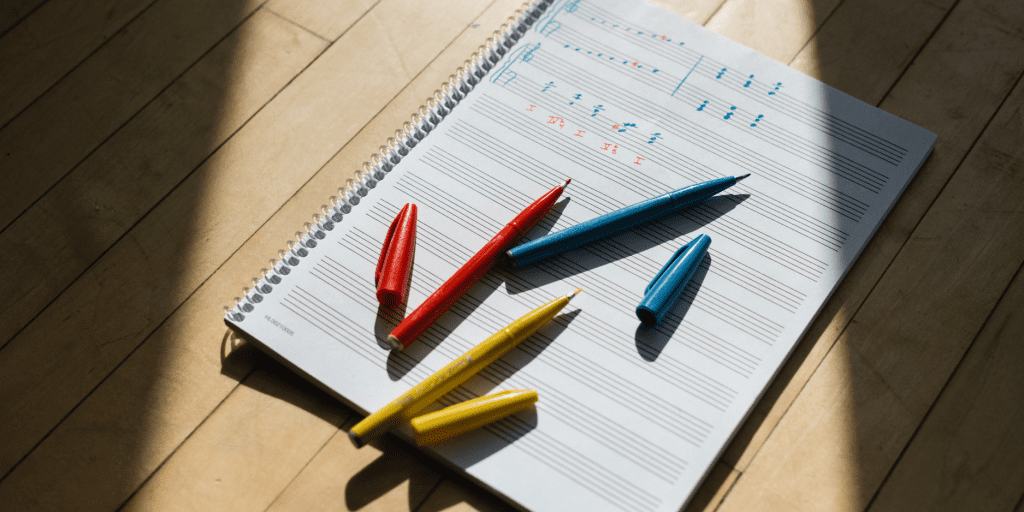
This week we invited our followers to submit questions for Jason Sifford about utilizing improvisation and percussion activities in the piano lesson. Today, Jason is answering those questions in advance of our creative music making webinar, “Incorporating Improvisation, Composition, and Non-Traditional Instruments in Piano Lessons” with Jason and his co-presenters Grace Huang and Kevin Woosley.
We encourage you to join us for this live webinar on Wednesday, December 7, 2022 at 11am Eastern. Register by clicking here.
Join us on social media for the opportunity to have your questions on a variety of interesting topics answered by additional experts in the coming weeks.

Improvisation
What first inspired you to start incorporating improvisation into your teaching?
I often notice students doing things that make good musical sense but aren’t in the score. Improvisation is like a musical playground, a safe place where you won’t be criticized for playing forte when it’s “supposed” to be piano, or when you want to end a piece on a major chord instead of a minor chord.
What do you do to build confidence in students who are hesitant to improvise?
For hesitant improvisers, we’ll just dip our toes in the pool. Rather than face a blank slate, we’ll take a piece they’re working on and change one element of it—rhythms, notes, or change the style (turn a lyric piece into a scherzo, or swing the eighths in a Classical sonatina.)
What would you say to a teacher who is intimidated to improvise themselves, much less teach improvisation?
I’d suggest finding some other musicians to play with, and try something besides piano! Several years ago, I had some friends in an Irish folk ensemble, so I got a cheap tin whistle and joined some of their sessions. I was awful! But it took me out of my comfort zone, and I found myself taking chances that I wouldn’t have done seated at a piano. So…look for an Irish session, a drum circle, play tambourine in a rock band, anything to put yourself in an unfamiliar situation.
Do you have an order or “curriculum” for improvisation that you give your students? If so, what are your first few foundational activities?
I don’t have a set curriculum. Since every student is different, I tend to build activities out of the repertoire they’re playing. This way, the activities are always level-appropriate and in a style the student is already exploring.
Do you have students give their improvisations titles? If so, what are the one or two most creative titles you’ve seen students give?
Most recently, a student of mine was playing a piece called “Somber Procession.” He came up with a really upbeat version of the tune which he called “Not-So-Somber Procession.” We even treated it like two different pieces. I told him that for our MTA festival, he had to play “Somber Procession,” but he could also play “Not-So-Somber Procession” at the recital!
How would you go about incorporating improvisation in the group setting? I want it to be truly group participation, but find that some students are much more shy than others when it comes to creative music making.
I’ve only done small groups of three or four students, so I’ll have the most fearless improviser handle the melody, put another courageous soul on percussion, and have the reluctant improviser handle a bass line (either written-out or taught by rote.)
Do you use improvisation activities in every lesson?
I don’t. It’s one of those things that’s in the toolbox—I bring it out if I think it’ll be useful or provide a change of scenery, but I always try to remind myself that I can’t do it all. We have to feel good about what we do in a lesson and avoid feeling bad about what we didn’t do. (Because the list of things we did do is always going to be bigger than the list of things we didn’t!)
For intermediate students who are learning modal scales, how would you suggest incorporating the modes into improvisation?
Since I tend to build improvisation exercises out of repertoire, I look for pieces in different modes or invent simple left-hand parts that suggest a particular mode or style.
Percussion Activities
What percussion instrument(s) have been student favorites?
I have a drum machine that I keep on top of the piano. They love it!
Where can you buy percussion instruments to use in lessons?
I’m lucky enough to live a mile from the West Music headquarters. They specialize in educational/classroom music and always have a lot of great items at the store. (And they have a great online shop that I’ve used in the past, too!)
Do you have any favorite collections of beginner percussion/piano duets?
I don’t! Almost all of our percussion work is improvised. I made some simple flash cards with rhythms on them that we’ll use, or I’ll teach them some basic drum set patterns (which I usually learn from YouTube tutorials!) The trick is to keep it simple. Have a Latin piece? Grab a plastic egg shaker and play eighth notes. That’s really all you need!
Do you use percussive instruments with students of all levels? If so, could you provide some examples? Sometimes I have a hard time thinking beyond quarter-note activities.
As students get older and more advanced, I tend to encourage them to explore their school jazz and marching bands. Piano students are a perfect fit, and I find that school ensembles are often better equipped to provide the social interactions and aural experiences that help take kids to that next level.

Don’t forget! Register for Jason’s upcoming webinar on creative music making by clicking here.